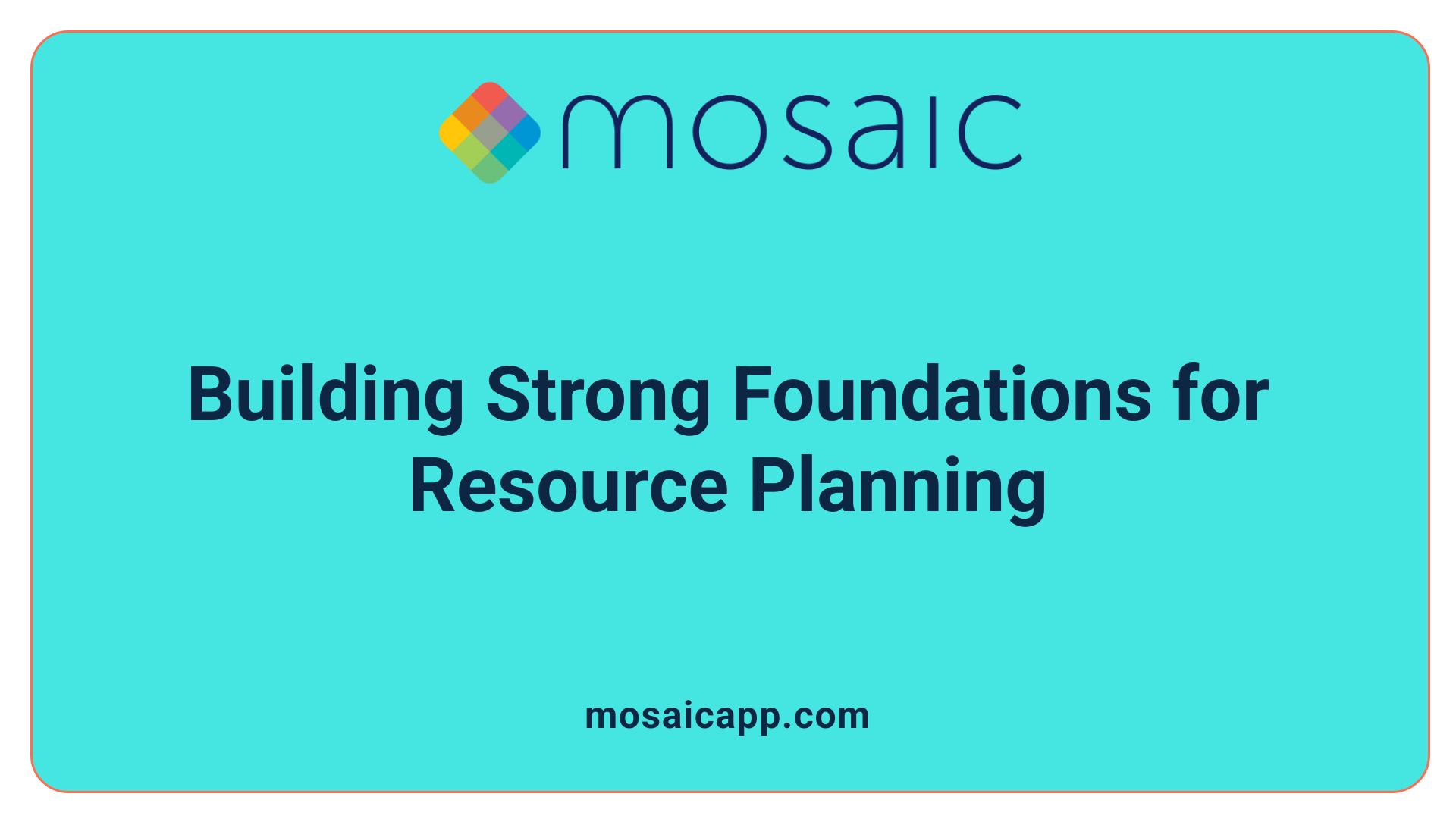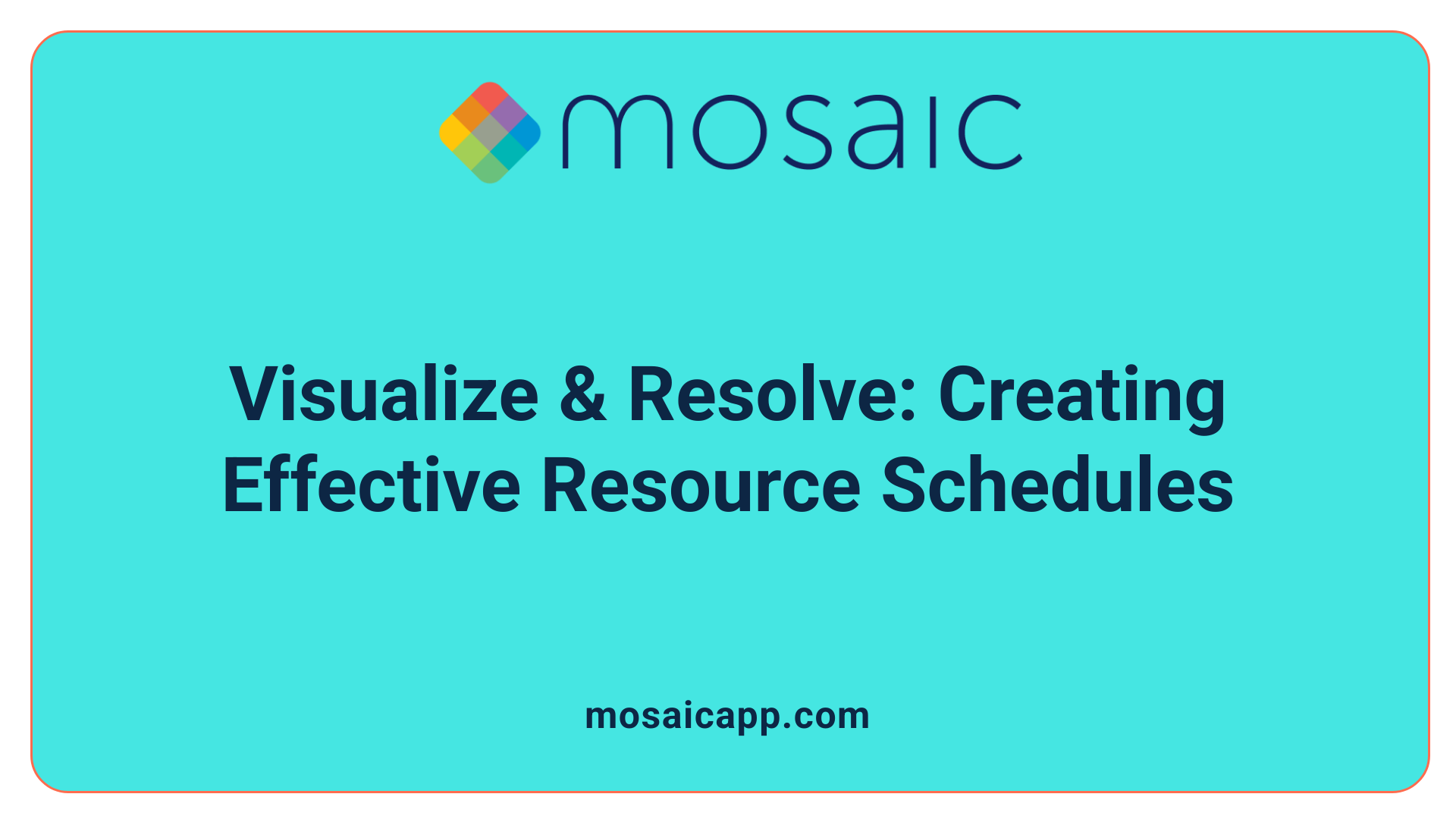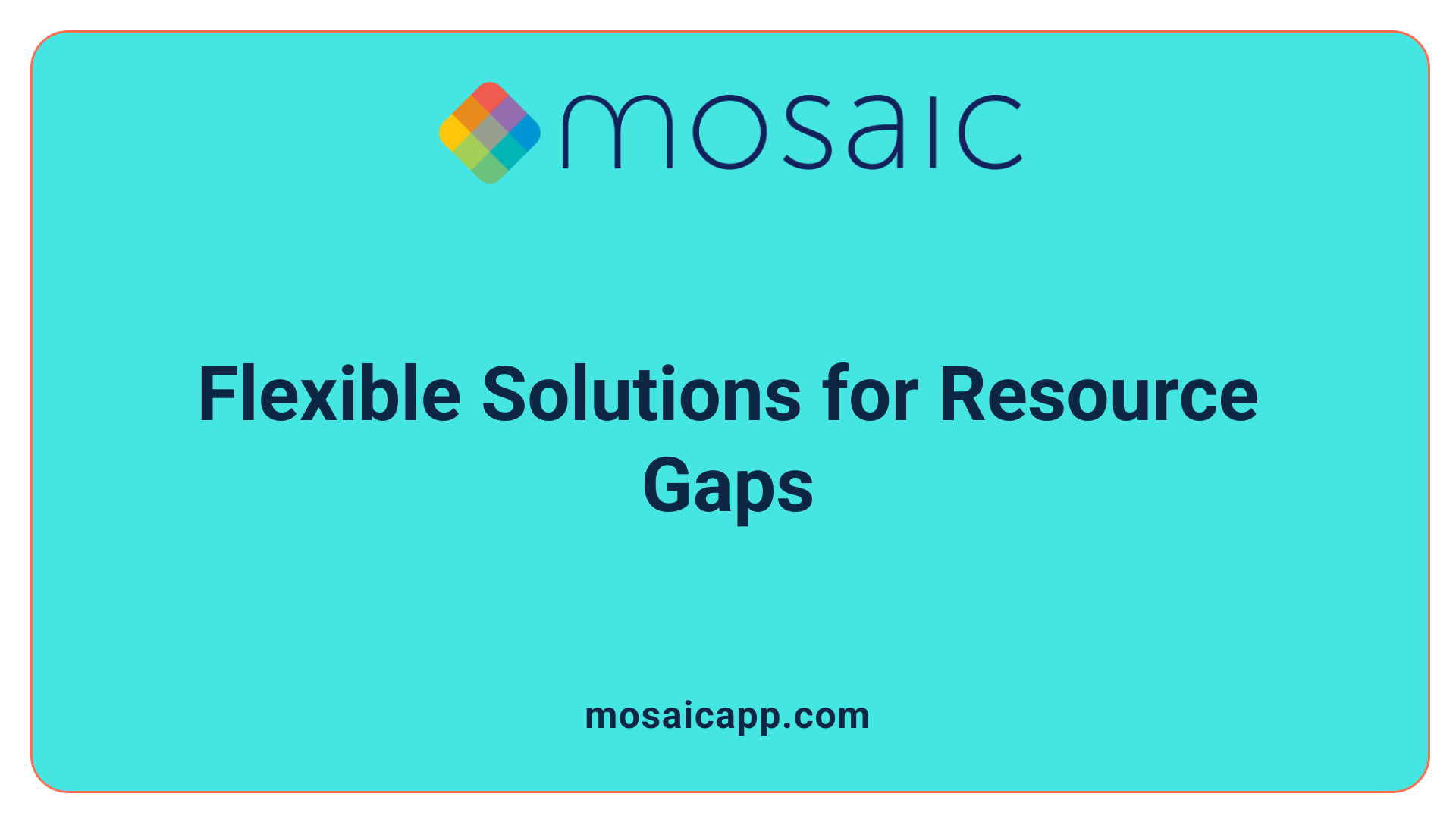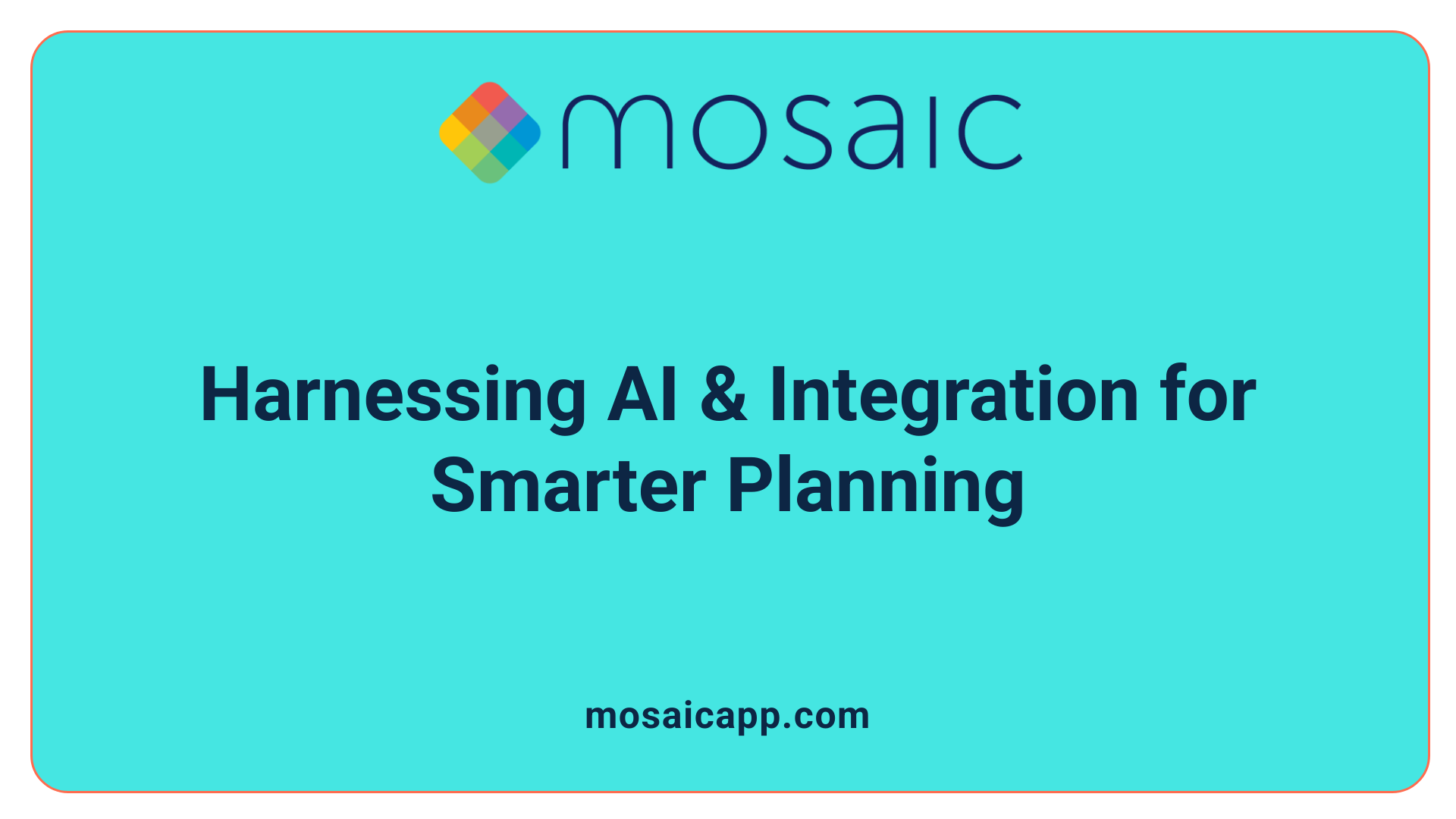The Shift from Strain to Sustainability in Project Teams
In today's fast-paced and complex project environments, overworked teams are a critical risk to achieving sustainable growth. Strategic and smarter resource planning emerges as the solution to transforming team dynamics, enhancing productivity, and ensuring long-term project success. This article unpacks the essentials of effective resource management and how organizations can harness advanced tools and methodologies to move from burnout to balanced, efficient project delivery.
Foundations of Effective Resource Planning

What constitutes effective resource planning?
Effective resource planning is about crafting a detailed strategy to allocate and manage all resources critical for project success — including personnel, tools, budgets, and materials. This strategic approach ensures that every task has the right resources at the right time.
Key components of a resource plan
An effective resource plan is comprehensive and includes several important elements:
- Resource requirements: Identifying all personnel, equipment, and materials needed.
- Roles and responsibilities: Matching tasks to team members based on skills and availability.
- Allocation plan: Scheduling resources to avoid conflicts and balance workloads.
- Resource calendar: Visual timelines showing availability and commitments.
- Acquisition plan: Strategies for obtaining additional resources if gaps arise.
- Training needs: Identifying and planning for skill development.
- Constraints and assumptions: Recognizing limitations, such as budget or availability, and documenting assumptions for transparency.
- Contingency plans: Preparing for risks and unexpected changes.
Starting point for resource planning
Resource planning begins with a clear understanding of the project scope and objectives. Developing the Work Breakdown Structure (WBS) is crucial as it breaks the project into manageable components, which helps pinpoint exact resource needs. By defining what the project entails and separating work into tasks, planners can accurately estimate the quantity, skills, and timing of required resources.
This structured foundation supports resource allocation decisions that minimize risks such as overallocation or project delays.
By integrating these elements, organizations create resource plans that are realistic, flexible, and aligned with project goals, thereby enhancing the chances of successful project delivery.
Strategic Resource Allocation: Matching Skills and Capacity to Project Needs

How do smart planners allocate resources effectively?
Smart resource allocation involves carefully matching project tasks with team members based on their specific skills and current availability. This approach ensures that the right people are assigned to the right jobs, enhancing productivity and quality.
Skill-based role assignment
Assigning roles by skill requires a thorough understanding of each team member's expertise and experience. Project managers must consider both the nature of the task and the individual's capability to deliver efficiently. Collaboration with department heads can help verify these skills and streamline assignments.
Estimating resource quantities and timelines
Accurate estimation is critical for effective planning. This involves evaluating how many resources are needed and how long each task will take. Techniques such as analogous estimation (drawing on past project data) and parametric estimation (using mathematical relationships) support precise forecasting.
Capacity and availability considerations
Resource capacity and availability must be analyzed to avoid overloading or underutilizing team members. Planners incorporate resource calendars and visualize workloads to detect conflicts and balance assignments across time frames.
Handling constraints and buffer time
Accounting for potential constraints like limited skills, equipment shortages, or unforeseen delays is essential. Including buffer time cushions the schedule against risks and provides flexibility to adapt to changing conditions.
Strategically allocating resources by aligning skills, availability, and realistic timelines—while addressing constraints—helps create balanced workloads. This approach prevents burnout, minimizes bottlenecks, and increases the chances of project success.
Creating Resource Schedules to Reveal and Resolve Bottlenecks

How does scheduling support smarter resource planning?
Resource scheduling is a vital tool for smarter resource planning because it provides a visual timeline that aligns specific tasks with the availability of resources. This clarity helps project managers quickly spot workload imbalances and potential conflicts, such as overbooked personnel or equipment.
Visual scheduling tools
Visual scheduling tools offer intuitive calendars or Gantt charts that display resource allocation over time. These tools highlight when resources are fully booked or underutilized, providing a clear picture of project progress and resource engagement. By seeing all assignments laid out visually, it becomes easier to assess if workloads are fairly distributed.
Aligning workloads with availability
By mapping tasks against each team member’s availability, project managers can balance workloads effectively. This alignment prevents team burnout and ensures that no resource is stretched beyond capacity. It also allows tasks to be scheduled when the right skills and equipment are accessible, improving productivity.
Identifying gaps and bottlenecks
Scheduling reveals gaps where resource capacity is insufficient to handle workload peaks, as well as bottlenecks where too many critical tasks depend on the same limited resources. Early detection of these issues enables timely adjustments, such as reallocating tasks, extending deadlines, or acquiring additional resources.
Role of modern project management software
Modern project management software platforms enhance scheduling with real-time utilization tracking, skill-filtering capabilities, and automated conflict detection. These features offer proactive alerts for potential overallocations and offer scenario planning to test different allocation strategies. Integration with other business systems streamlines workflows and improves planning accuracy.
Overall, effective resource scheduling supported by advanced tools transforms resource planning from guesswork into a dynamic, data-driven process that improves project efficiency and team well-being.
Addressing Resource Gaps: Flexible Solutions for Dynamic Projects

How Are Resource Gaps Identified?
Resource gaps become apparent when there is a mismatch between the project needs and the availability or capacity of allocated resources. Tools like resource schedules and visual workload charts highlight conflicts, bottlenecks, or overallocation. Regular status reviews and continuous monitoring further reveal shortages early, enabling timely intervention.
What Strategies Mitigate Resource Shortages Effectively?
When resource deficiencies arise, effective strategies include procuring additional personnel or equipment, reallocating tasks among existing team members, utilizing temporary or contract resources, adjusting project schedules to fit actual resource availability, and, if necessary, reducing project scope. Flexibility and swift adaptation in resource planning help maintain progress and control over project timelines and budgets.
Practical Solutions to Fill Resource Gaps
- Procurement of New Resources: Acquiring additional tools, equipment, or hiring new staff to meet the demand.
- Reassignment of Tasks: Shifting responsibilities within the team based on skills and availability.
- Temporary Resources: Bringing in contractors or temporary workers to handle workload spikes.
- Schedule Adjustments: Modifying task timings to align better with resource availability.
- Scope Reduction: Prioritizing critical work and scaling back less urgent tasks to stay within constraints.
By combining these approaches, project managers can navigate dynamic project environments and keep projects on track despite resource challenges.
Leveraging Technology: AI and Integration in Modern Resource Planning

How does technology enhance the effectiveness of resource planning?
Technology plays a transformative role in modern resource planning, especially through Artificial Intelligence (AI) and integration of comprehensive business platforms. AI automates routine planning tasks, reducing manual workload and minimizing human error, while providing powerful insights via real-time analytics and predictive capacity planning.
Platforms such as Asana, Jira, Microsoft Project, and Smartsheet serve as centralized hubs that aggregate data, visualize workloads, and alert teams to potential conflicts or bottlenecks. Smartsheet and BQE CORE, for example, combine scheduling with financial planning and resource allocation to ensure balanced workloads and optimized project profitability.
Real-time utilization tracking and behavioral profiling enabled by AI help project managers understand team capacity and dynamics more deeply, allowing for adaptive scheduling that accounts for productivity variations and prevents burnout.
By integrating resource management tools with broader business systems, organizations gain enhanced accuracy, streamlined workflows, and greater flexibility. Scenario planning features allow proactive responses to changing project conditions, fostering smarter, data-driven decisions.
Overall, these technological advances elevate resource planning beyond traditional spreadsheet methods, supporting more efficient, agile, and strategic project execution.
Avoiding Burnout: The Role of Resource Leveling and Workload Balancing
What is Resource Leveling and Its Benefits?
Resource leveling is a project management technique used to create realistic schedules by addressing resource overallocation. It involves redistributing tasks to prevent overloading team members, which helps avoid project delays, missed deadlines, and team burnout. By optimizing resource usage and balancing workloads, resource leveling leads to more feasible project timelines and greater efficiency.
How Does Resource Leveling Prevent Team Burnout?
Resource leveling prevents burnout by reallocating tasks to match team members’ availability and capacity. This method adjusts task start and end dates, sometimes extending project timelines, and prioritizes critical tasks to ensure workloads are manageable. Unlike resource smoothing, which keeps deadlines fixed, resource leveling allows flexibility to reduce pressure on the team, improving morale and sustaining productivity over the project's life.
Key Techniques Used in Resource Leveling
- Adjusting schedules: Shifting task start and end dates to align with resource availability.
- Extending timelines: Allowing more time for task completion to avoid overloading.
- Reallocating resources: Assigning tasks to different team members based on skills and capacity.
- Prioritizing critical tasks: Ensuring essential activities receive focus to maintain progress.
- Using project management tools: Employing software for visualization and conflict detection.
Resource Leveling vs. Resource Smoothing
While resource leveling may extend project timelines to resolve overallocations, resource smoothing maintains even work distribution without changing deadlines. Smoothing is ideal for projects with fixed deadlines needing workload balance within strict timeframes, whereas leveling offers more flexibility to prevent burnout and schedule conflicts.
Impact on Team Morale and Project Success
By evenly distributing workloads and aligning tasks with resource availability, resource leveling reduces stress and prevents fatigue. This sustainable approach fosters higher team morale, leading to increased engagement and productivity. Consequently, projects benefit from higher success rates, fewer delays, and better quality outcomes.
| Aspect | Resource Leveling | Resource Smoothing |
|---|---|---|
| Objective | Resolve overallocations, possibly extend schedule | Balance workloads without changing deadlines |
| Flexibility | High — may adjust timelines | Low — deadlines fixed |
| Impact on Team | Prevents burnout, reduces stress | Provides steady workload |
| Suitable for | Projects with flexible deadlines | Projects with fixed deadlines |
| Techniques | Adjust start/end dates, reassign tasks, prioritize | Shift tasks within available float time |
From Tactical to Strategic: Evolving Project Management Roles in Resource Oversight
How are project management roles evolving in relation to resource planning?
Project management has undergone a significant transformation, moving from strictly tactical, process-oriented duties to a strategic role that shapes business outcomes through effective resource management. This evolution parallels the widespread adoption of agile and hybrid methodologies, with over 70% of organizations embracing these flexible approaches as per the 2023 PMI Pulse of the Profession report.
Today, project managers are no longer just task assigners; they are pivotal leaders responsible for integrating resource orchestration across multiple teams and aligning project objectives with organizational strategy. This requires a profound expansion in their skill set beyond traditional project management competencies.
Core skills now include:
- Data Fluency: Leveraging analytics and AI-driven insights to optimize resource allocation and predict capacity needs.
- Emotional Intelligence: Navigating team dynamics and fostering collaboration in diverse and often remote environments.
- Systems Thinking: Understanding how various project components, resources, and business units interact to craft coherent solutions.
- Cross-Boundary Collaboration: Breaking down silos and partnering with department heads to ensure realistic resource commitments and address bottlenecks early.
Elevating the role of project managers involves greater participation in long-term organizational planning and design. They engage in shaping workflows, adopting centralized platforms for better visibility, and integrating AI-powered tools to enhance predictive resource planning. This strategic involvement turns project management functions into a business engine that drives change, enhances efficiency, and boosts stakeholder confidence.
Ultimately, this shift positions project managers as central figures in the future of resource planning — combining technical acumen with leadership and strategic foresight to achieve sustainable project success and competitive advantage.
Enterprise PMO Resource Management: Aligning Portfolio Resources with Business Impact
What distinguishes PMO resource management from project-level planning?
PMO resource management differs fundamentally from project-level planning by focusing on the entire project portfolio rather than individual projects. It acts as a strategic coordination function that aligns people, skills, and capacity across multiple projects simultaneously. Unlike project-level resource allocation, which is limited to task assignments within a single project, PMO management ensures resources are optimized for business impact over an ongoing basis.
What is the four-phase PMO resource management process?
The PMO resource management framework is structured around four key phases:
- Strategic Planning: Defining resource needs aligned with business objectives across the portfolio.
- Smart Allocation: Matching skills and capacities to projects effectively, often by leveraging centralized resource pools.
- Real-time Tracking: Monitoring resource utilization and availability continuously to detect conflicts and bottlenecks early.
- Continuous Optimization: Using analytics and automated workload balancing to adjust allocations dynamically and improve efficiency.
What techniques enhance PMO resource management?
Several advanced methods support PMO effectiveness:
- Dynamic Capacity Planning: Adjusting resource forecasts based on evolving project demands and team availability.
- Centralized Resource Pools: Aggregating skills and talent into shared pools to maximize flexibility.
- Skills-based Matching: Assigning resources based on expertise to optimize performance.
- Utilization Analytics: Measuring and analyzing how resources are deployed to detect inefficiencies.
- Automated Workload Balancing: Leveraging technology to evenly distribute tasks and prevent overallocation.
What benefits arise from effective PMO resource management?
A sophisticated PMO resource management practice yields measurable advantages:
- Faster Project Delivery: By eliminating resource conflicts and streamlining workflows.
- Optimized Resource Utilization: Ensuring maximum productivity without burnout or idle capacity.
- Stronger Strategic Alignment: Aligning resource allocation with organizational objectives and priorities.
- Enhanced Risk Mitigation: Early identification and resolution of resource-related risks reduce project disruptions.
Through a comprehensive, portfolio-wide approach, enterprise PMOs transform resource challenges into strategic opportunities, driving better business outcomes and competitive advantage.
Data-Driven Forecasting and Continuous Adaptation for Sustainable Growth
How do forecasting and adaptability drive smarter resource planning?
Accurate resource forecasting forms the foundation of efficient project management. Two prominent techniques are analogous estimation, which leverages data from similar past projects, and parametric estimation, which employs data-driven relationships to predict future resource needs. These methods enhance the precision of resource requirement estimations, enabling teams to allocate personnel, budget, and materials more effectively.
The importance of monitoring actual resource usage and variances
Beyond initial forecasts, continuous oversight is vital. Monitoring actual resource consumption against planned usage highlights discrepancies early, allowing managers to detect variances that could affect project timelines or budgets. Early identification of these deviations ensures that corrective steps can be taken before issues escalate.
Adaptive planning to cope with changes
Adaptive resource planning integrates real-time data insights to adjust schedules, workload distributions, and resource assignments as projects unfold. This dynamic approach accommodates shifting priorities, unexpected availability changes, and evolving project scopes, preventing delays and inefficiencies. By incorporating buffer time and contingency planning, adaptive strategies sustain project momentum even amid uncertainty.
Role of regular feedback and flexible adjustments
Regular feedback loops empower project teams to remain aligned and responsive. Open communication channels enable quick reporting of emerging challenges or resource bottlenecks. Flexible adjustments based on this feedback foster resilience, ensuring that resource plans evolve in harmony with project realities. This ongoing collaboration supports sustainable growth by balancing workload demands and resource capacity effectively.
Together, these data-driven forecasting methods and continuous adaptive mechanisms make resource planning not just a one-time activity but a dynamic, evolving process that underpins the success and sustainability of modern projects.
Breaking Down Silos: Centralization and Enhanced Visibility for Resource Efficiency
Assessing Current Tools and Processes
Many organizations still rely on fragmented tools and disconnected systems to manage their resources. This separation often leads to incomplete visibility of workloads and capacity and hinders efficient collaboration among teams. Evaluating the existing resource management processes helps identify gaps that cause bottlenecks or resource conflicts.
Adopting Centralized Work Management Platforms
Centralized platforms unify resource allocation, scheduling, and workload tracking into a single system. These platforms break down silos by consolidating data from different departments and projects, creating a clear, real-time picture of resource utilization. Such centralization supports better coordination and allows project managers to balance workloads more effectively across teams.
Benefits of Visibility and Cross-Team Collaboration
With centralized visibility, organizations can spot resource gaps and overallocations early. This transparency facilitates smoother handoffs between teams and encourages collaborative planning. Teams work together more cohesively, which minimizes delays and reduces the risk of burnout. Enhanced cross-team communication also strengthens stakeholder confidence and improves overall project outcomes.
Facilitating AI Integration and Automation
Centralized resource management platforms provide an ideal foundation for integrating AI-powered tools. These tools automate routine tasks such as scheduling adjustments and conflict detection, and deliver predictive insights to anticipate future resource needs. AI integration streamlines workflows and supports data-driven decision-making, enabling faster responsiveness to shifting project demands.
Why is centralization critical to smarter resource planning?
Centralizing resource management through unified work platforms breaks down organizational silos, enhances visibility into workloads and capacities across teams, and fosters collaboration. This holistic transparency uncovers bottlenecks early, improves alignment, and enables seamless AI integration for automation and predictive analytics. The result is streamlined workflows, informed decision-making, and more effective resource utilization, which collectively support sustainable project delivery and growth.
Best Practices for Building Resilient and Engaged Project Teams
Clear communication and employee training
Maintaining open, transparent communication channels ensures all team members understand project goals, resource availability, and potential constraints. Employee training keeps skills current and promotes confidence in task execution, which reduces errors and improves productivity.
Cross-training and skills development
Encouraging cross-training increases team flexibility by enabling members to cover multiple roles. This adaptability helps manage workload fluctuations and reduces bottlenecks, strengthening overall team resilience.
Balancing short-term demands with team sustainability
Teams must carefully balance immediate project pressures with sustainable workloads. Incorporating buffer time into project schedules allows room for unexpected issues and prevents resource overload, thus avoiding burnout.
Establishing buffer time and risk registers
Proactively including buffer periods and documenting assumptions and risks in registers equips teams to anticipate and mitigate problems before they escalate. This systematic approach supports continued progress despite uncertainties.
Implementing these best practices results in reduced delays, improved morale, and an engaged workforce capable of sustaining high performance over multiple projects. By fostering a healthy team environment that prioritizes sustainable resource use and clear communication, project success becomes more achievable and predictable.
Embracing Smarter Resource Planning for Sustainable Growth
Transitioning from overworked project teams to sustainable organizational growth requires a strategic overhaul of resource management practices. By adopting comprehensive resource planning, leveraging AI and integrated tools, deploying resource leveling techniques, and elevating project management roles, organizations can optimize workloads and enhance efficiency. Centralized platforms and data-driven forecasting provide the visibility and agility necessary to adapt in dynamic environments. Ultimately, embracing these smarter planning methodologies not only protects teams from burnout but also drives improved project outcomes and long-term business success.
References
- Guide to Resource Planning in Project Management
- Your Guide to a Project Management Resource Plan
- The Strategic Evolution of Project Management
- The Importance of Resource Management in Project Success
- Mastering Resource Planning and Project Scheduling in ...
- Resource Leveling: Balancing Workloads for Project Success
- The Complete Guide to Project Resource Planning in 2025
- How To Master PMO Resource Management In 2025

